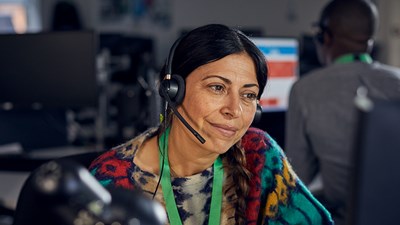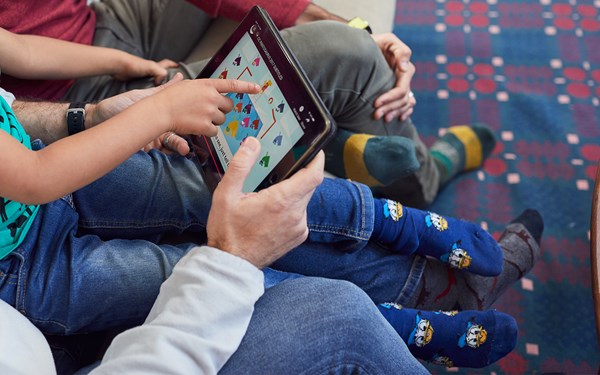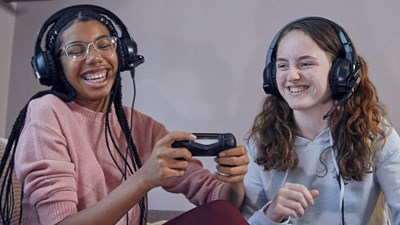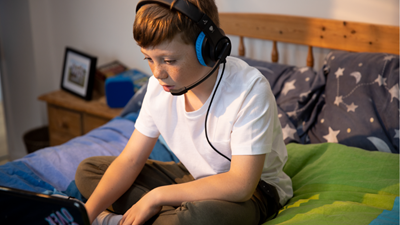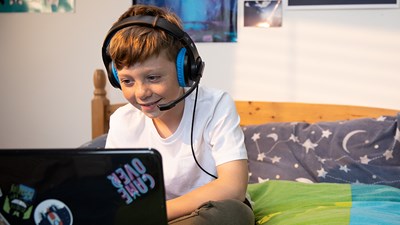Deciding what’s appropriate for children to see online
The online world gives us access to a huge amount of information and services, but the scale of information available also means that there is content that is inappropriate for children. What is or isn’t appropriate is up to individual parents and carers to decide, and could be based on things like age, ability, beliefs and family values.
What are parental controls?
Parental controls allow you to block and filter upsetting or inappropriate content. They work across your WiFi, phone network, individual apps and devices.
Parental controls can help you to:
- plan what time of day your child can go online and how long for
- create content filters to block apps that may have inappropriate content
- manage the content different family members can see.
Setting up parental controls on:
Home internet providers can offer parental controls for your family. You can:
- use a filter from your internet provider to control the content that you and your family see. Some providers allow different settings for each user
- set up any device connected to your home broadband. How you do this depends on your provider and you'll need to access your home router. You can ask your internet provider for help setting this up. Remember that this only affects your child accessing the internet through the WiFi – if they are using 4G or 5G etc to connect you need to check the settings on their mobile device too (see below).
Most games consoles have internet access, which means your child can go online and chat with other players or make in-game purchases. On many consoles there are parental controls which allow you to manage which features are available to your child. On some devices you can:
- turn off chat functions to stop your child from talking to people they don't know
- restrict games based on age
- turn off in-game purchases, or set a limit.
Check the website for the console your child has for a parents section and details of features. Some games also allow you to change settings for that individual game.
PlayStation Family Management
On PlayStation consoles you can set up a Family Manager account which allows you to manage different accounts for different children/users. Within this you can manage a range of features, such as restricting communication with other players, restricting content, setting play time controls and set spending limits. See all the features available for PS4 and for PS5.
All mobiles, tablets and computers have parental control settings, which can differ between devices, these include:
- allowing or disallowing in-game or in-app purchases
- settings such as location settings and what information your child is sharing
- wellbeing settings to help with limiting screen time.
You can get more advice about setting up controls on different devices from your mobile provider and the UK Safer Internet Centre.
On Apple devices such as iPhone, iPad, Apple Watch, Apple TV etc. there are features available for parents all tied into an account. You can set content and privacy restrictions, prevent purchases, allow or disallow apps and more. See what parental controls are available on Apple iOS devices.
Many social media, apps and online services such as film and TV streaming services have features such as:
- content filters
- chat filters
- privacy settings
- in-app purchase settings.
You can find out about these features by looking in the settings on each app, or take a look at their website for more information. They might be called settings, family features, privacy or security.
Facebook has a Parents portal which helps explain the features available.
For Netflix, you need to visit the website to set up parental controls – we suggest you do this as soon as you create an account.
Microsoft Family Safety – by creating a family group you can manage many settings, such as setting screen time limits, blocking inappropriate content, receive activity reports, set app and game limits and more. To learn more about Microsoft Family Safety see the Microsoft page and Xbox Family Settings.
Sometimes, innocent searches can lead to not so innocent results. If you're worried:
- make sure the content your child sees online is appropriate for their age by using parental controls and filters in search engines like Google, Yahoo and Bing
- make sure you have set parental controls on the home broadband and devices.
Google Family Link - a very useful app to manage a range of features such as restricting content, approving or disapproving apps, setting screen time and more. For lots of useful information see the Google FAQ page.
The controls you've set up on your child's device and your home broadband won't work if they use 3G or 4G, public WiFi or log onto a friend's connection instead. Remember:
- public WiFi is often available when you're out and about, but it's not always safe
- some public places and businesses offer family-friendly WiFi. When you see the family-friendly WiFi symbol it means there are filters to stop children from seeing inappropriate or upsetting content
- talk with your child and agree what they can and can't do online. If your child is visiting friends or family, remember that they might not have the same controls set up.
Need advice about online safety?
If you’re stuck, not sure what to do, or if you’re worried about your child, you can also contact our trained helpline counsellors on 0808 800 5000.
Childline also has lots of information about online and mobile safety that will help you and your child.
The limits of parental controls
Whilst parental controls are a helpful tool there are limitations. So they shouldn’t be seen as a whole solution. Even if you’ve put things in place on your home broadband and your child’s device, they won’t help if your child connects to a different WiFi with no controls in place.
Parental controls are just part of the way you can help keep your child safe online.
More top tips include:
- Talking to your child. Explain why you are setting parental controls; to keep them safe. But also let them know that they can talk to you to discuss why certain settings are in place.
- Set good, strong passwords where you are able. On some parental controls you can set a password which prevents settings and features from being changed.
- Age is a significant factor; as children get older, restrictions and controls you use will change, but only at a pace that is appropriate for your child, not pressure from your child “because everyone else is allowed”.
- Content filters are never 100% effective, it is likely at some point that your child will see inappropriate or upsetting content and it is important that you are able to talk to them about this.
